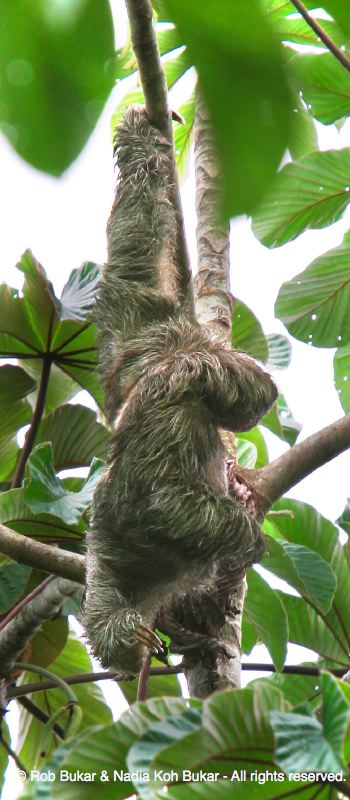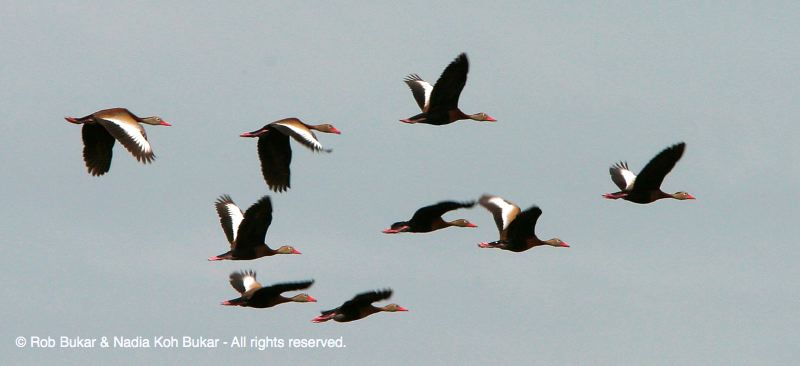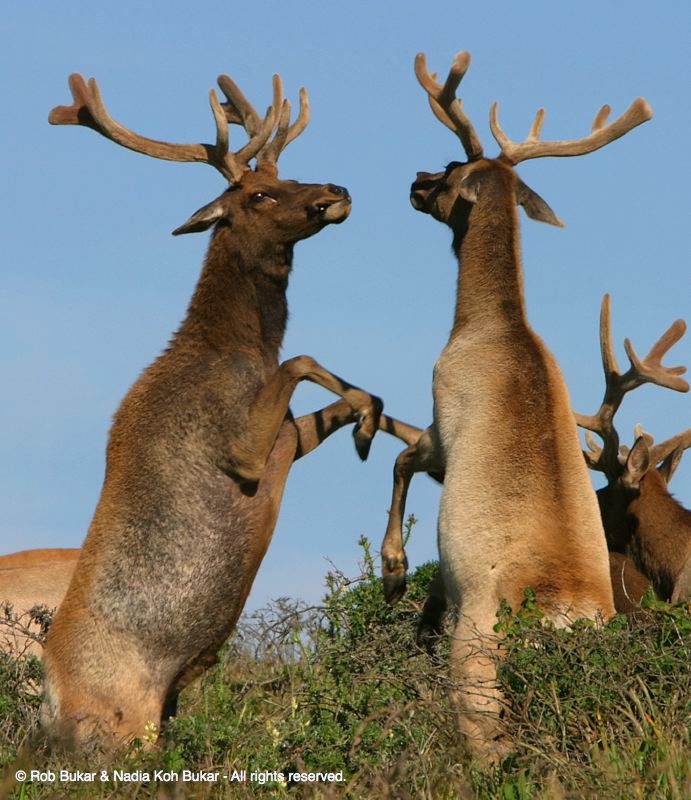70-200mm 2.8 L IS and Extender EF 1.4x II Discussion
Sloth Costa Rica |
Birds Costa Rica |
Elk Point Reyes |
This
lens combination has become my favorite, to my surprise.
Previously I had a 200mm and a 1.5X extender both of which I didn't use
very often. The 200mm was large and heavy and it never really
gave me enough power or resolution to capture the animal life I was
going after. When I used it in conjunction with my 1.5X extender I
started to get enough power to capture some wildlife, but the
resolution of the shot looked terrible with the 1.5X extender
attached. It was also very difficult to use without a tripod
because of camera shake.
After I decided to purchase the Canon 10D I began doing research into lenses. First I had to decide what focal lengths I wanted to cover, and next what lens quality I wanted to pay for. After, reading many web sites it became clear that most pro's recommended Canon L glass. This is Canon's top of the line lenses and they cost significantly more than their other lenses. Any Canon lens that has an L in the name is considered top quality. You can go to Canon's web site and read the difference in the type of glass used if you like. For myself, it doesn't matter what Canon says about the glass quality because I don't understand it anyway. What mattered to me is what users saw in their pictures.
From all the research I did (and now from my own experience) what you get with a top quality lens is much higher sharpness throughout the entire field of view, especially when the lens is wide open; less distortion (pincushion for wide angle lenses and barrel distortion for telephoto lenses); better contrast; less flare, faster and more accurate auto focus; and better build quality.
I have been quite amazed by the quality of photos I have been able to achieve with the above lens combination. To be honest I rarely use the zoom without the 1.4X Extender attached. When taking photos of animal life it seems rare that you have too much power. All three photos above were shot at 200mm with the 1.4X extender, this gives a final focal length (corrected by 1.6x for the small sensor size) of 448mm. I have taken photos with and without the Extender and to my eye I can see no loss in sharpness in the final image. At full zoom the images are amazingly sharp, detail rich, and have great tone and contrast.
All of the above images where also significantly cropped. The Elk has been cropped approximately 3X, the birds 5X, and the Sloth 10X!!! And still there is an amazing amount of detail present. I printed the Elk out at approximately 11x14 and it still looks great! I didn't save the information on the Elk, but the Sloth was shot at f 4.5 and 200 ISO, while the birds were shot at f 16 and 400 ISO. Since the Sloth image is cropped so much you can't tell if there is any distortion in the image at 4.5, but it sure was nice to have such a wide aperture available on such a large zoom. Now the birds were shot at 400 ISO, and still there is very little noise in the image. This is a testament to the 10D; even at 1600 ISO the noise levels are surprisingly low.
In addition to the above zoom being an L class lens it also has Image Stabilization, which is designated by the IS in it's name. Image Stabilization is an amazing technology that Canon employs to reduce shake in it's higher powered lenses. All of the above photos were hand held. I have actually never used a tripod with this lens combination. If you have never tested out Canon's IS technology I strongly recommend you go to a camera store and try it out. At 448mm and IS off you can see a lot of camera shake, once you switch the IS on it is magically reduced by a surprising amount. This lens combination would be significantly less useful without the IS technology since I don't often bring my tripod along and set up and wait for animal shots to happen upon me.
I must add that all of my images have gone through Photoshop. I crop, sharpen, employ noise reduction techniques, adjust contrast, saturation, and sometimes tone on most of my photos. Out of the camera the images don't look as good, but in my opinion this is the great benefit of the digital world. I believe that you should take all of your favorite images and mess with them in Photoshop. But remember, in photography your photos will only be as good as your weakest piece of equipment. If I was shooting with a lesser camera and with inexpensive lenses I would not have been able to achieve the quality of photos shown above, even with the help of Photoshop.
Photo Equipment SectionAfter I decided to purchase the Canon 10D I began doing research into lenses. First I had to decide what focal lengths I wanted to cover, and next what lens quality I wanted to pay for. After, reading many web sites it became clear that most pro's recommended Canon L glass. This is Canon's top of the line lenses and they cost significantly more than their other lenses. Any Canon lens that has an L in the name is considered top quality. You can go to Canon's web site and read the difference in the type of glass used if you like. For myself, it doesn't matter what Canon says about the glass quality because I don't understand it anyway. What mattered to me is what users saw in their pictures.
From all the research I did (and now from my own experience) what you get with a top quality lens is much higher sharpness throughout the entire field of view, especially when the lens is wide open; less distortion (pincushion for wide angle lenses and barrel distortion for telephoto lenses); better contrast; less flare, faster and more accurate auto focus; and better build quality.
I have been quite amazed by the quality of photos I have been able to achieve with the above lens combination. To be honest I rarely use the zoom without the 1.4X Extender attached. When taking photos of animal life it seems rare that you have too much power. All three photos above were shot at 200mm with the 1.4X extender, this gives a final focal length (corrected by 1.6x for the small sensor size) of 448mm. I have taken photos with and without the Extender and to my eye I can see no loss in sharpness in the final image. At full zoom the images are amazingly sharp, detail rich, and have great tone and contrast.
All of the above images where also significantly cropped. The Elk has been cropped approximately 3X, the birds 5X, and the Sloth 10X!!! And still there is an amazing amount of detail present. I printed the Elk out at approximately 11x14 and it still looks great! I didn't save the information on the Elk, but the Sloth was shot at f 4.5 and 200 ISO, while the birds were shot at f 16 and 400 ISO. Since the Sloth image is cropped so much you can't tell if there is any distortion in the image at 4.5, but it sure was nice to have such a wide aperture available on such a large zoom. Now the birds were shot at 400 ISO, and still there is very little noise in the image. This is a testament to the 10D; even at 1600 ISO the noise levels are surprisingly low.
In addition to the above zoom being an L class lens it also has Image Stabilization, which is designated by the IS in it's name. Image Stabilization is an amazing technology that Canon employs to reduce shake in it's higher powered lenses. All of the above photos were hand held. I have actually never used a tripod with this lens combination. If you have never tested out Canon's IS technology I strongly recommend you go to a camera store and try it out. At 448mm and IS off you can see a lot of camera shake, once you switch the IS on it is magically reduced by a surprising amount. This lens combination would be significantly less useful without the IS technology since I don't often bring my tripod along and set up and wait for animal shots to happen upon me.
I must add that all of my images have gone through Photoshop. I crop, sharpen, employ noise reduction techniques, adjust contrast, saturation, and sometimes tone on most of my photos. Out of the camera the images don't look as good, but in my opinion this is the great benefit of the digital world. I believe that you should take all of your favorite images and mess with them in Photoshop. But remember, in photography your photos will only be as good as your weakest piece of equipment. If I was shooting with a lesser camera and with inexpensive lenses I would not have been able to achieve the quality of photos shown above, even with the help of Photoshop.
Main Menu
Photos by Rob Bukar